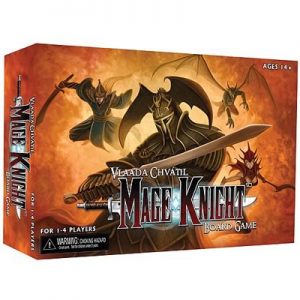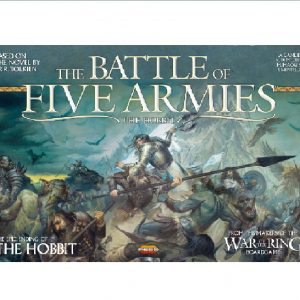Beschrijving
Min leeftijd: +14
Aantal spelers 2 a 3
Gem speelduur 240 a 360 min
Conquest and Consequence brengt het Triumph & Tragedy-systeem naar het theater in de Stille Oceaan en Oost-Azië in dezelfde periode van 1936-1945. Net als T&T is het ontworpen voor drie spelers, waarbij de driezijdige dynamiek behouden blijft die zoveel variatie en intriges aan het systeem toevoegt. Die drie kanten zijn:
Het militaristische Japan, de eerste Aziatische macht die moderniseert, probeert de Europese koloniale rijken in Oost-Azië te vervangen door een echt ‘volledig Aziatisch’ imperium, met zichzelf als de natuurlijke leider.
De communistische Sovjetfractie, die bestaat uit de Siberische USSR en de Rode Chinese revolutionairen.
De kapitalistische VS-factie, die bestaat uit de Verenigde Staten, het Britse rijk en het worstelende regime van het nationalistische China.
Het spel begint in 1936 met de militaristen die de controle over Japan hebben en uitbreiding op de agenda staat. De oorlogsindustrie is goed ontwikkeld, maar zwak qua bevolking en vooral qua middelen. Het door de strijd geharde leger heeft het hulpbronnenrijke Mantsjoerije gemakkelijk onder de voet gelopen, en een zwak China wacht. Japan (net als Duitsland in T&T) heeft het vroege initiatief dankzij zijn goed voorbereide leger. Zal het:
Zuidwaarts, China in?
Neem de ‘Noordelijke Weg’ naar het hulpbronnenrijke Oost-Siberië (zoals begunstigd door het leger)?
De ‘Zuidelijke Weg’ naar het olierijke Nederlands-Indië volgen, waar de marine voor pleit?
Of zijn tijd afwachten, op zoek naar een betere positie via diplomatieke overeenkomsten met neutrale landen, waaronder onafhankelijke Chinese krijgsherenstaten?
De Japanse agressie in China zal waarschijnlijk de slapende reus, de VS, irriteren, maar het ligt ver weg aan de overkant van de brede Stille Oceaan, en Japan beschikt over speciale maritieme capaciteiten waardoor het op zee kan concurreren.
De Rode Chinezen hebben zojuist hun Lange Mars voltooid en hun basis opnieuw gevestigd in het binnenland van Shaansi, ver van gebieden van Japans (of kapitalistisch) belang. De Rode Chinezen zijn militair erg zwak, maar hebben een geheim wapen: partizanen. Dit zijn niet-militaire ‘politieke’ organisaties (weergegeven op de kaart met kartonnen tellers) die moeilijk uit te roeien zijn, zich vermenigvuldigen als ze worden genegeerd, en indien gewenst kunnen worden omgezet in militaire eenheden (dit is onverstandig zonder voldoende concentratie). De Sovjet-Unie, die zich ook terdege bewust is van het Japanse expansionisme, is wanhopig bezig Oost-Siberië te versterken, dat verder nauwelijks verdedigd wordt. Het nationalistische China is zich bewust van de Japanse dreiging, maar moet ook omgaan met de interne communistische dreiging. De Verenigde Staten zijn ontwapend, ongeïnteresseerd en afgeleid door de Grote Depressie. Het Britse rijk is jammerlijk onderverdedigd en overmoedig. Het Amerikaanse bondgenootschap moet zijn economie opbouwen en tegelijkertijd op de een of andere manier de militaire capaciteiten van het Britse Rijk, het nationalistische China en zichzelf verbeteren.
Het spel combineert de zeeoorlog in de Stille Oceaan en de landoorlog in Azië (inclusief de Chinese burgeroorlog), die beide even zwaar wegen op de overwinning. De zeeoorlog is dramatisch, met korte, beslissende veldslagen en uitgebreidere rollen voor luchtmacht en eilandbases. In de traditie van Triumph & Tragedy omvat het driezijdige aspect onderhandeling, diplomatie en uitvluchten binnen een veelheid aan strategische mogelijkheden. Net als T&T geeft het spel spelers de vrijheid om af te wijken van de neigingen en het beleid van de historische acteurs en speelt het spel in 4-6 uur van constante spanning en betrokkenheid.
Conquest and Consequence brings the Triumph & Tragedy system to the Pacific/East Asia theater during the same 1936-1945 time period. Like T&T, it is designed for three players, maintaining the three-sided dynamic that adds so much variety and intrigue to the system. Those three sides are:
Militarist Japan, the first Asian power to modernize, which seeks to replace the European colonial empires in East Asia with a true “all-Asian” empire, with itself as the natural leader.
The Communist Soviet faction, which is comprised of the Siberian USSR and the Red Chinese revolutionaries.
The Capitalist USA faction, which consists of the United States, the British Empire, and the struggling regime of Nationalist China.
The game begins in 1936 with the Militarists in control of Japan and expansion on the agenda. Its [war] industry is well-developed, but it is weak in population and particularly resources. Its battle-hardened army has easily overrun resource-rich Manchuria, and a weak China awaits. Japan (like Germany in T&T) has the early initiative due to its well-prepared military. Will it:
Move south into China?
Take the “Northern Road” into resource-rich east Siberia (as favored by the army)?
Pursue the “Southern Road” to the oil-rich Dutch East Indies advocated by its navy?
Or bide its time, seeking a better position via diplomatic arrangements with neutrals including independent Chinese warlord states?
Japanese aggression in China will likely irritate the sleeping giant that is the USA, but it is far away across the wide Pacific, and Japan has special naval abilities that allow it to compete at sea.
The Red Chinese have just completed their Long March and re-established their base in inland Shaansi, far from areas of Japanese (or Capitalist) interest. The Red Chinese are very weak militarily but have a secret weapon: Partisans. These are non-military “political” organizations (represented on-map with cardboard counters) that are difficult to eradicate, multiply if ignored, and can be converted into military units when desired (this being ill-advised without sufficient concentration). The Soviet Union, also acutely aware of Japanese expansionism, is desperately fortifying eastern Siberia, which is otherwise thinly defended. Nationalist China is aware of the Japanese threat but must also deal with the internal Communist threat. The United States is disarmed, disinterested, and distracted by the Great Depression. The British Empire is woefully under-defended and overconfident. The USA alliance must build up its economy while somehow improving the military capabilities of the British Empire, Nationalist China, and itself.
The game combines the Pacific naval war and the land war in Asia (including the Chinese Civil War), both equally weighing upon victory. The naval war is dramatic, featuring short, decisive battles and expanded roles for airpower and island bases. In the tradition of Triumph & Tragedy, the three-sided aspect features negotiation, diplomacy, and subterfuge within a multitude of strategic possibilities. Like T&T, the game allows players freedom to diverge from the inclinations and policies of the historical actors and plays in 4-6 hours of constant tension and involvement.







